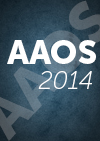
AAOS: Age and Tegner associated with risk of re-rupture and re-injury after ACLR

AAOS: Age and Tegner associated with risk of re-rupture and re-injury after ACLR
Risk of Re-injury at Two Years: A Randomized Clinical Trial Comparing Three Graft Types for ACL Reconstruction
Did you know you're eligible to earn 0.5 CME credits for reading this report? Click Here
CONFERENCE ACE REPORTS
This ACE Report is a summary of a conference presentation or abstract. The information provided has limited the ability to provide an accurate assessment of the risk of bias or the overall quality. Please interpret the results with caution as trials may be in progress and select results may have been presented.
Synopsis
330 patients scheduled for anterior cruciate ligament reconstruction were randomized to undergo surgery using either a patellar tendon autograft, quadruple-stranded hamstring tendon autograft, or double-bundle reconstruction with hamstring tendons. The purpose was to evaluate each with respect to disease-specific ACL quality of life, and identify any possible predictors of traumatic re-rupture, tr...
To view the full content, login to your account,
or start your 30-day FREE Trial today.
FREE TRIAL
LOGIN
Forgot Password?
Explore some of our unlocked ACE Reports below!

Learn about our AI Driven
High Impact Search Feature
Our AI driven High Impact metric calculates the impact an article will have by considering both the publishing journal and the content of the article itself. Built using the latest advances in natural language processing, OE High Impact predicts an article’s future number of citations better than impact factor alone.
Continue



 LOGIN
LOGIN

Join the Conversation
Please Login or Join to leave comments.